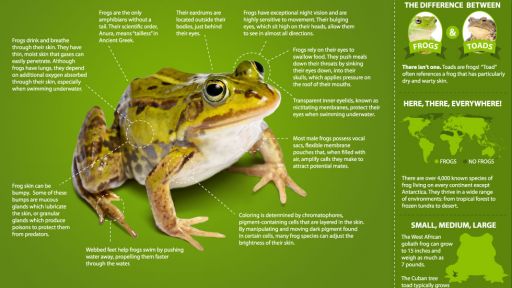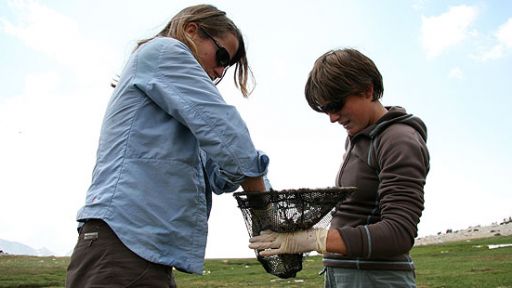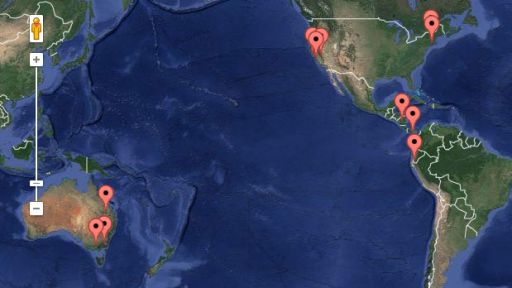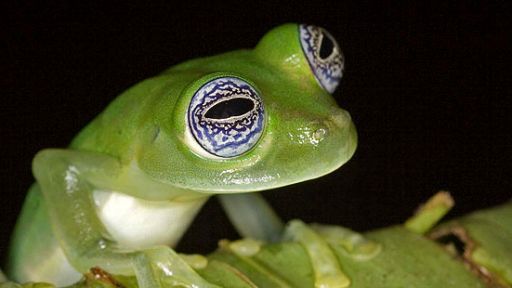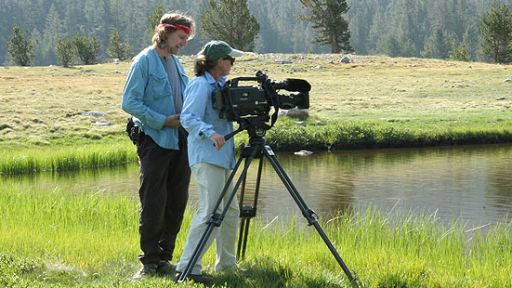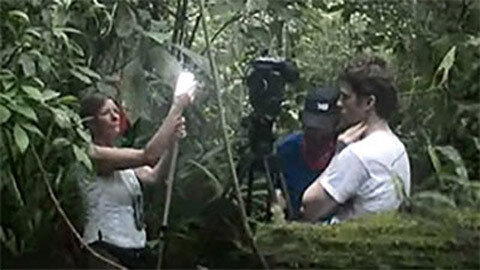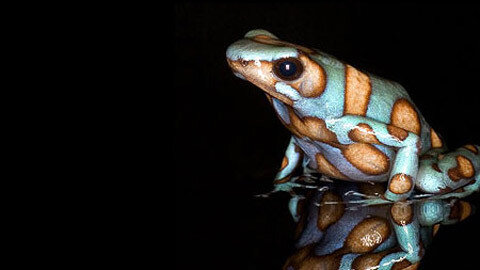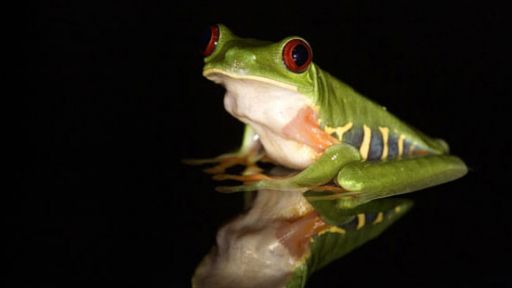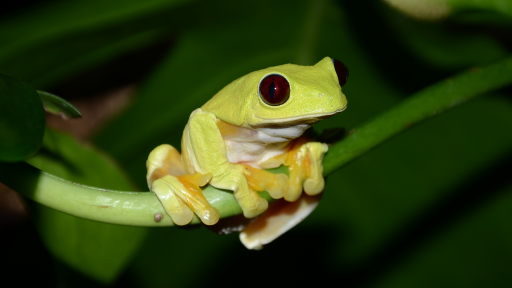Send in your questions for Allison Argo, the director of Frogs: The Thin Green Line. On the night of the premiere — Sunday, April 5 — Allison will answer your questions here.
Submit your question for Allison in the comments box below.
Allison Argo is dedicated to producing television programming that she hopes will make a difference. She describes her work as an exploration of the landscape where human and animal collide. A champion of endangered life, her films provide a voice for those who have none, be it endangered frogs, chimpanzees in captivity or people who have been compromised by a changing world.
As producer, director, and writer for nearly 20 years, Allison’s adventures have carried her across the globe. Her films have won numerous international awards, including six National Emmys, the prestigious duPont Columbia Award for Journalism, and multiple Genesis, New York Festival, CINE Golden Eagle, Christopher Columbus, Jackson Hole, Missoula, and Japan International Wildlife awards.
Before Frogs: The Thin Green Line, Allison directed several other films for NATURE: Extraordinary Dogs, Wisdom of the Wild, The Urban Elephant, Chimpanzees: An Unnatural History, and Crash: A Tale of Two Species.
You can also read her recent blog post about the U.S. State of the Birds report, which warned that one-third of U.S. bird species are in trouble.
Here are answers to some of your questions:
Brian Watts asks: Ms. Argo: Is it difficult to find financial support for projects on “unglamorous” species’ documentation and protection?
Allison Argo says: Hi Brian – That’s a good question! I am happy to say that NATURE asked me to make this film and provided the funding (bravo NATURE!). I have always been a champion of the planet’s less glamorous species – and it used to be far more difficult to get funding to tell their stories. Fortunately times seem to be changing. I think we’re all beginning to understand that even the smallest, most unassuming creatures play an important role.
—
Carolyn asks: has anyone thought about contamination by researchers going from one area to another and carrying the kittrick(sp)(virus)on their clothing, boots, hands, etc.? if there is no way to stop it then maybe it also cannot be destroyed by usual means of disinfection. just a simple thought…
Allison says: Hi Carolyn – Absolutely! You ask a really important question. Scientists carefully disinfect their boots and all of their gear when moving from site to site these days. While we were filming, we washed our boots thoroughly and any gear that touched the earth in a mild Clorox solution when leaving an infected site – we even washed our vehicle. Unfortunately, this wasn’t done back when chytrid hadn’t yet been identified. It certainly is possible that researchers (and tourists) tracked chytrid into areas not yet infected. It’s also possible that chytrid is carried on the feet of ducks & birds. Scientists like Karen Lips are trying to find out just how the fungus travels, but as far as I know, there are only theories at this point.
—
Jim Whalen asks: I recently saw a show on animal planet bout this problem that is affecting frog populations worldwide. The same scientist mentioned in natures program claims some progress against chytrid is being attained. People around the world have to wake up and stop are irresponsible treatment of the earth. Amphibians might be ” the canary in the coal mine”
Allison says: Yes! We all need to take responsibility. Most scientists agree that the problems amphibians are facing are also impacting other species (including humans). It’s a very serious situation.
—
Christopher asks: First, thank you for a superb presentation of chytrid. What can I as an individual do to make the frog species thrive?
Allison says: Thanks, Christopher! It might sound small, but we can all make a difference by changing our energy consumption and use of chemicals at home – we can buy organic whenever possible and buy locally. Also, we should all support local efforts to restore & protect wetlands (keep your eye out for local projects). For other ideas, check out the “Additional Web Resources” page. There are excellent groups that can use your support and offer more ideas (www.amphibianark.com is a good one). Thanks for wanting to make a difference!
—
Dan Nordmann asks: The conservation that is promoted in this program confuses me. It is important to be aware of how we effect our animal counterparts. When is it important to step aside and let mother nature takes it course? What if the frogs have been selected by mother nature to have a decline in their populations? How do we know that there was not a decline 500 hundred years back or even 5,000 years ago. A blink of time really, for having been around for 250,000 million years.
This show unfortunatley does not effectively explain why a decline in population is a negative occurence. What if the fungus is strengthening the amphibians by causing them to adapt? Well; if that’s what’s going on and we stop this process then we might be causing a much bigger problem! Perhaps this is the paradox of the conservation movement. All in all the show is thought provoking and the filming is very nice. Thanks for the film!
Allison says: Hi Dan. I guess we’re going to have to see how this thing plays out. I am not a scientist myself, but all the scientists I spoke to seem very concerned about the consequences of losing the earth’s amphibians. They are finding that insect species are on the rise and other species that prey on amphibians are disappearing. I, personally, am very concerned about our water quality. I can’t imagine that pouring chemicals into our water supply is ultimately going to do us any good either… You’re right, it is thought provoking!
—
Cindy asks: How can a person get involved on a local scale? I live in PA – are there groups in my area?
Allison says: Cindy – I’m not linked into local groups, but it might be possible to find a local network through one of the international frog non-profits (www.amphibianark.com is a good one). They might be able to help hook you up with local efforts in PA. Also, read my response to Christopher’s note (above). We can all make a significant difference by making some changes at home.
—
Tucker Farley aks: who was the wonderful and caring black man caring for frogs and going out to search for them? Panama I think it was. Everyone else was introduced.
Allison says: Hey Tucker — That is Edgardo Griffith (working at EVACC in Panama with his wife Heidi Ross). They’re both wonderful people and totally dedicated to helping frogs.
—
Patti asks: I live in Louisiana. What can I do to help the frogs of the world? What can I do to encourage their thriving in my local area?
Allison says: Hi Patti – Read my response to Cindy (above). I applaud you for wanting to make a difference!
—
Alice Moon asks: I want to know how the researcher in California can be sure his frogs didn’t swap sexual identities due to being in a population consisting solely of males.
Allison says: Hi Alice – So sorry, but I’m not able to address your question. It is really a question for Tyrone Hayes. I do know that he is a very highly-respected scientist, and I trust that he’s looking at all angles in order to fully understand his findings. Sorry I can’t offer any insights here!
—
Marjorie Chelberg asks: I recently asked the pharmacist at WalMart what should I do with unused prescriptions, she said to just flush them down the toilet. What can I do to make people in my neighborhood with septic systems more aware as their water and street run off ends up in a creek behind our home which is inhabited by lots of frogs. Should they be disposed of like the drs. do with used needles? Or what else can be done? Great film, I really enjoyed it.
Allison says: Wow, that’s unfortunate “guidance” the pharmacist gave you! Dr. Dave Skelly (from Yale University) advises: “Unused pharmaceuticals can be returned to the pharmacy. Many hospitals will also take them. They are sent to special incinerators that make them inert.” This information really should be made more accessible to the general public and pharmacists should be better informed.
—
Judy asks: I also want to know what we can do locally. I would think that the first step is to teach the school children. Outside of that, what would I do?
Allison says: Judy – Yes! That’s a really critical point. Here’s a link for teachers & parents: teach the kids – http://www.helpafrog.org/toolkit.htm. Kids love frogs and don’t want to see them disappear. You can also read what I’ve written above in response to Christopher. We can all make a big difference right in our own backyards. And do click on some of those links to see what the non-profit groups suggest. They know where help is needed most. Again, thanks!
—
Ann Gutierrez asks: I am the owner of land in Costa Rica where the only known colony of Atalopus varius (harlequin frog previously thought to be extinct) was re-discovered several years ago. In response to Carolyn’s comments regarding contamination, I believe her concern is valid and one probable cause of the widespread contamination. It is my understanding that Reid Harris at James Madison University in Va. is working on a bath dip to immunize these frogs that retards the development of the Chytrid fungus. My biggest problem to safeguard this fragile colony stems from frog poachers hoping to add to their exotic collection. We need world wide legislation that makes this activity a serious crime.
Allison says: Hi Ann – Thanks so much for your note. Yes, Carolyn brought up a very important point (see my response above). And I’m so glad you mentioned Reid Harris – he is doing some very exciting research. I have high hopes that his work will help us turn a corner with chytrid. You also make a really important point about “collecting”. It takes a serious toll on fragile populations and is a horribly selfish (and illegal) act. This is just one more pressure that we are putting on amphibians. I wish I’d had time to include this point in the film. Alas, 51 minutes is just too short when trying to convey so many complex issues. Thanks for bringing it up!!
—
Ross Geredien asks: Thank you, thank you for your compelling work. I am a former student of David Skelly’s and was thrilled to see his work on amphibian diseases incorporated into this comprehensive discussion on global amphibian declines.
Not only are declines in rainfall caused by climate changes causing drastic ecological changes to frog habitat, but climate change is most likely also driving the spread of chytrid fungus in places like the neotropics. Alan Pounds’ work in Costa Rica has documented how increased cloud cover and humidity is creating the perfect conditions for the fungus in cloud forest systems.
Perhaps one of the biggest things we can do is to buy local and organic and reduce the amount of pesticides and atrazine spread on the earth’s surface and reduce the amount of energy it takes to transport food by purchasing food grown closer to home.
Allison says: Ross – Amen! I have vowed to start buying organic foods whenever possible and to buy them locally. Making this film really drove home for me how we can all make a significant difference. I’m hoping that in my local community we can get our town to ban the use of fertilizers and pesticides. It might take a while, but I think it’s worth the battle. There are viable alternatives! The first step is being informed – the second step is making positive choices. (PS: You’re a lucky guy to have studied under David Skelly. He must be a great teacher!)
—
Bill Magno asks: Nature tonight on saving the frogs around the world was wonderful and bought tears to my eyes. THANK GOD there are people on the planet in Parks and Wildlife dept’s helping to save the frogs. These are the true saints of society. We should give them every support
Allison says: Thanks so much for your note, Bill. I couldn’t agree with you more. There are some heroic folks out there working to turn this crisis around.
—
Catareina Heinrick asks: I am 19 and trying to raise money to help fund the research and conservation efforts of frogs, and have two questions: Who do I send the money to? And how do I contact them? I have tried searching on the UC Berkley and Yale home pages and found not luck what so ever in even finding such programs as what you filmed in, Frogs: The Thin Green Line. Any help would be greatly appreciated. As of yet I have not raised any money, I just saw the show three hours ago!
Allison says: Hi Catareina. I applaud your efforts to help raise funds on behalf of amphibians! I think it might be best to contact one of the amphibian groups that are non-profits (www.amphibianark.com) . If you go to the “Additional Web Resources” page on NATURE’s Frogs website, you’ll find a list of groups that are devoted to helping frogs. They know where funding is needed most and can advise you. Thanks so much for caring!!
—
Parker Fritz asks: where can i send schwabs to be tested?
Allison says: Parker — There is a very specific protocol for swabbing amphibians, so that the test is accurate. It would be best to contact one of the excellent groups like www.amphibianark.org to ask about the specifics. From what I gather, there are not many labs that process the swabs. Hope this helps point you in the right direction…
—
141lanka asks: I have researched on Sri Lankan amphibians/reptiles under Dr.Carl Gans. Can you update me the status of Chytrid in Sri Lankan amphibian populations ?. I would love to get a copy of your show to educate Sri Lankan students/young researchers. Let me know if you would love to visit Sri Lanka I can give you field assistance and info !
Allison says: I had the good fortune of traveling to Sri Lanka some years ago when I made a film on elephants (The Urban Elephant). It is a magnificent place – and I worked with some top-notch people there. Unfortunately I don’t know the status of chytrid in Sri Lanka, but here is a website that might have some info for you: http://www.parcplace.org Thanks and good luck with your work!
—
Randy Heuser asks: Question: If Chytrid infects frogs and snakes, does it also infect turtles?
Allison says: Randy – As far as I know, the amphibian chytrid fungus affects only amphibians. However, any species that preys on frogs (or is preyed on by frogs) is indirectly affected. So yes, it’s possible that turtles are being impacted.
—
Christine asks: I thought the program was well done but was dismayed that the issue of biosecurity was not discussed with regard to field work. I kept wondering how many frogs died because well intentioned scientists and film crews spread the fungus on their boots to uninfected areas. Was there any effort for field scientists and film crews to disinfect boots, clothing, vehicles and other gear?
Allison says: Hi Christine – You bring up a really important point. Scientists (and film crews) carefully disinfect their boots and all of their gear when moving from site to site these days. We washed our boots thoroughly and any gear that touched the earth in a mild Clorox solution when leaving an infected site – we even washed our vehicle thoroughly. Sadly this wasn’t done back when chytrid hadn’t yet been identified. It’s altogether possible that researchers – and tourists visiting the National Parks – tracked chytrid into areas that were chytrid-free. It’s also possible that chytrid is carried on the feet of ducks & birds. Scientists like Karen Lips are trying to find out just how the fungus travels, but as far as I know, there are only theories at this point.


